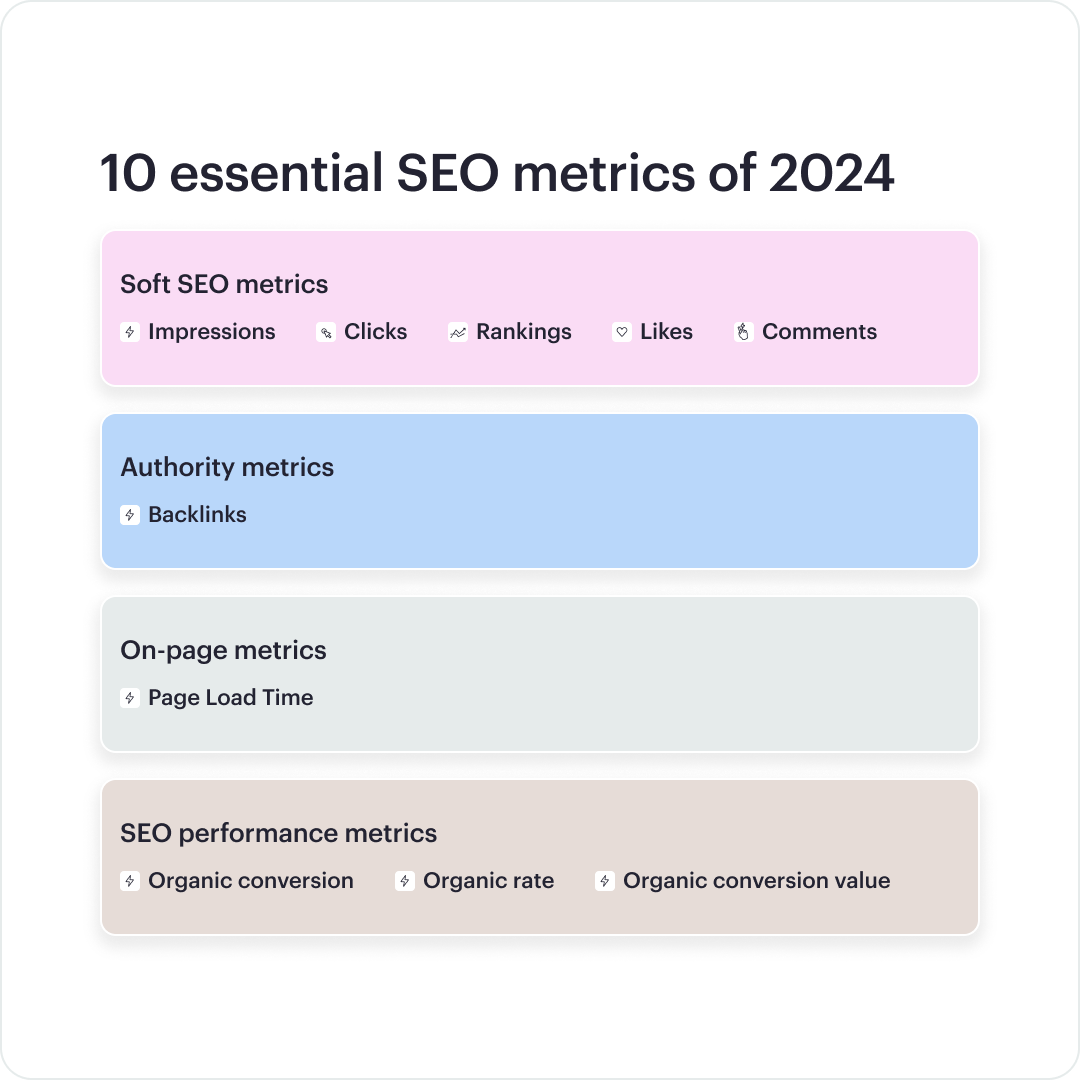10 essential SEO metrics for 2024

Mihalis Tsiropoulos
SEO Operations Lead
In SEO, we often find ourselves focusing on the softer side of things – organic impressions, clicks, and rankings. It’s not surprising, since tools like Google Search Console and Bing Webmaster Tools only report on these metrics in their performance reports.
However, relying solely on organic impressions, clicks and rankings doesn’t give you the full picture of your SEO performance. Nor does it help you understand how to prioritise your SEO efforts.
In this article, we’ll walk you through 10 essential SEO metrics for 2024 that will guide you in understanding SEO’s true value. Read on to learn how you see SEO as an extension of your business strategy and make sure it contributes to either profitability or ROI.
We’ve divided these metrics into 4 categories:
- Soft SEO metrics: 1) Organic impressions, 2) Clicks, 3) Rankings, 4) Likes, 5) Comments
- Authority metric: 6) Backlinks
- On-page metric: 7) Page Load Time
- SEO performance metrics: 8) Organic conversions, 9) Organic conversion rate, 10) Organic conversion value
Psst! This article is part of a 3-part series about the basics of SEO. We write about keyword research, keyword analysis, and on-page optimisation here and 5 easy steps to measure SEO value here.
1. Soft SEO metrics: organic impressions, clicks, rankings, likes, and comments
The three most common SEO metrics are organic impressions, clicks and rankings. Although they do not provide the full image of performance, they still support a relevant understanding of how well our SEO efforts have contributed to our positioning in search engines. So we regard these as soft metrics.
- Organic impressions give us a glimpse of our visibility
- Clicks indicate user interest
- Rankings showcase our standing in search results.
When including apps and social media in your SEO strategy, other soft engagement metrics, such as likes and comments, are also helpful to learn more about what has supported our growth. These metrics extend beyond traditional SEO but are equally crucial.
- Likes signify user appreciation
- Comments offer insights into user interaction
Integrating these metrics into our strategy provides a comprehensive view of what supports our growth. Recognising the importance of these soft metrics becomes integral, not only to refining our SEO strategy but also to aligning it with broader business objectives.
2. Authority metric: backlinks
Referring to links has been and most likely always will be a relevant part of how we measure the value of a website’s authority.
- Backlinks, or inbound links, are hyperlinks from external websites that direct users to your website.
- Backlinks serve as a crucial indicator of a website’s authority because they represent digital votes of confidence from other reputable sources.
- The quality and quantity of these backlinks not only contribute to the strength of the domain but also signal to search engines that the content is valuable and trustworthy.
Essentially, the more high-quality backlinks a website has, the more likely it is to be recognised as an authoritative and reliable source within its niche or industry.
- This recognition, in turn, enhances the website’s potential to outperform competitors in search engine rankings and reinforces its overall authority in the digital landscape.
3. On-page metric: page load time
Once users have landed on our website, the ultimate goal is conversion. But before expecting conversions, we need to invest in providing a great user experience.
Luckily, this experience can be measured, and significant improvement has been made since Google launched its Chrome User Experience Report (CrUX Report) in 2017. In the 2021 update, it evolved into a Page Experience report, examining various factors that impact a great user experience.
To break it down, “page load time”, or the time it takes for a web page to fully display its content, has always been a big deal, both in the 2017 and 2021 versions of these reports. Ensuring your page loads quickly is a game-changer for giving users a great overall experience.
In other words, page load time is a crucial on-page metric that measures the speed at which your website pages load for visitors. It directly influences user experience; the faster the page loads, the better the user experience. Users tend to bounce off slow-loading pages, affecting engagement and potentially leading to a loss in conversions.
As you might know, there’s more to the user experience story than just load times. There are other metrics worth exploring, such as custom-built events that focus on specific things users are into on our landing pages. These metrics are often customised to the unique characteristics of each website.
Acknowledging and tracking these user experience metrics becomes instrumental, not only in optimising individual landing pages but also in ensuring a holistic and effective approach to user experience across the entire website. This user-centric perspective aligns with the evolving landscape of digital interactions and contributes significantly to conversion success.
4. Performance metrics: organic conversion, organic conversion rate, and organic conversion value
When assessing the efficacy of our SEO strategy, organic conversion, organic conversion value, and organic rate are some of the most important performance metrics.
- Organic conversion measures the total amount of conversions.
- Organic conversion value takes a step further by assigning a monetary worth to these actions – showing us the financial impact.
- Organic conversion rate, a ratio of organic conversions to total organic sessions, providing a measure of conversion success. In other words, it’s the percentage of visitors from organic search who take desired actions, and it’s a good measure of how our SEO efforts are sparking meaningful interactions.
Why do these metrics matter? Well, they help us understand the effectiveness of keywords and landing pages and help us align SEO efforts with business goals.
- For e-commerce, understanding revenue from organic conversions is essential.
- For B2B, identifying how conversions translate into leads provides insights into generating business opportunities.
💡If you’ve made any on-page tweaks to your website, like making your site faster or boosting your authority with more backlinks, keep your performance analysis simple. Compare a period before and after your changes in the same year to see if your SEO moves hit the mark.
Reflections 🧠
Monitoring these metrics ensures that your SEO not only enhances website performance but also contributes meaningfully to your broader business objectives – and your profitability.
In other words, SEO metrics are our performance scorecard: they tell us how well our actions are paying off and whether or not (or how much) we’ve improved. The common go-to for a broader view is comparing year-to-year metrics to consider any seasonal quirks.
However, over the last few years, almost every industry has been through a rollercoaster, with the pandemic, inflation, and international geopolitical crises. When going through your performance scorecard, remember to:
- Add more context to your analysis – this means going beyond a year-to-year comparison and including a general perspective on the market.
- Avoid relying solely on results without understanding how seasonal trends might sway your audience and your business.
To add more context to your report, you can get very valuable information for both brands and topics by pulling a report from Google Trends (for Google Searches), TikTok Insights, and similar platforms.
💡At Precis, we’ve cooked up something we call the market opportunity assessment. It dives into search data from various sources, giving us the lowdown on the market and how well our clients stack up against their key competitors. Sounds like something you’d like to try out? Get in touch with us here.

Psst! This article is part of a 3-part series about the basics of SEO. We write about keyword research, keyword analysis, and on-page optimisation here and 5 easy steps to measure SEO value here.


